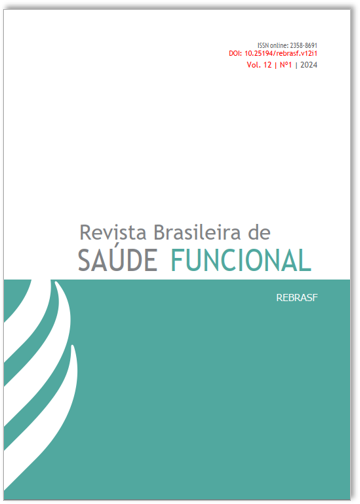DEVELOPMENT AND ACCEPTABILITY OF A GLUTEN-FREE PRODUCT USING PLANTAIN AND ARROWROOT FLOUR
DOI:
https://doi.org/10.25194/rebrasf.v12i1.1630Keywords:
Celiac disease, Gluten, Gluten Free DietAbstract
Introduction: Celiac disease (CD) and gluten sensitivity imply permanent dietary changes that can restrict food intake and result in nutritional deficiencies. In this way, the development of gluten-free products can contribute to an increase in food quality and variety. Objective: To develop a gluten-free product through the full use of plantain and arrowroot flour and carry out a sensory analysis to determine acceptance and purchase intention. Materials and methods: Fully using plantain and arrowroot flour, a product called “nhoque banaruta” was developed. The product was sensorially evaluated by the test of acceptability and purchase intention. Participants received and signed an informed consent form. Samples of “nhoque banaruta” were distributed in disposable plates to non-trained tasters (n=79), along with the evaluation form and a glass of water. The evaluation form contained the acceptance test using a structured nine-point hedonic scale, anchored in the terms: I really disliked (1) and I liked a lot (9) and the purchase intention test with a structured five-point scale, anchored in the terms: certainly would not buy this product (1) and would certainly buy this product (7). Results: The results of the sensory analysis indicated that the product was well accepted for all evaluated attributes (color, flavor, texture and aroma), with an acceptability index greater than 77%. The purchase intention of “banaruta gnocchi” was 85%. Conclusion: The “banaruta gnocchi” showed good acceptability and purchase intention, and can be used as an alternative gluten-free food for the public with restricted consumption of this protein, allowing an increase in the variety of preparations for these consumers.
References
Amparo GKS, Lima CFM, Silva AD, Nihei JS, Passos RA. Magalhães CG. The Celiac Disease Impact Towards The Adults’ Life Quality. J. res. fundam. care. Online. 2019; 11(3): 809-81. DOI: 10.9789/2175-5361.2019.v11i3.809-815
Carvalho VG, Queiroz NS. Sensibilidade ao glúten não celíaca em pacientes pediátricos: uma revisão da literatura. Residência Pediátrica. 2022; 12(3):1-6. DOI: 10.25060/residpediatr-2022.v12n3-569
Crucinsky J, Damião JJ, Castro IRR. Fragilidades no cuidado em saúde às pessoas com desordens relacionadas ao glúten. Cad. Saúde Pública. 2021; 37(2):e00244219. DOI: doi.org/10.1590/0102-311X00244219
Rodrigues VCC, Rodrigues KCC, Fialho CGO, Bastiani MID, Milagres RCRM, Souza ECG. Composição química e aceitabilidade de pão sem glúten desenvolvido com mucilagem de quiabo. Rev Inst Adolfo Lutz. 2020;79:e1786. DOI: doi.org/10.53393/rial.2020.v79.35483
Fideles MC, Bento JAC, Ferreira KC, Oliveira ALM, Caliari M, Júnior MSS. Physicochemical and technological characteristics of arrowroot flour modified by ultrasound and low-temperature heat treatment. Ciência Rural. 2019; 49(10):e20181037. DOI: doi.org/10.1590/0103-8478cr20181037
Araújo MS, Silva LCG, Andrade VQL, Carneiro APG, Costa EA, Fernandes LES. Araruta, seu beneficiamento e utilização em preparações gastronômicas. Research, Society and Development. 2021; 10(15):e387101522776. DOI: doi.org/10.33448/rsd-v10i15.22776
Lima NBF, Silva LB , Borges MV, Neves RR, Vera R, Ferreira GA. Caracterização do amido de araruta orgânica e potencial para aplicação tecnológica em alimentos. Desafios - Revista Interdisciplinar da Universidade Federal do Tocantins. 2019; 6 (Especial):118–126. DOI: doi.org/10.20873/uft.2359365220196Especialp118
Vilete JV, Poletto BO, Vieira R. Extração de lipídeos da banana-da-terra madura e tratamento de dados utilizando ferramentas quimiométricas. Revista Científica da Faculdade de Educação e Meio Ambiente. 2016; 7(2): 90-110. DOI: doi.org/10.31072/rcf.v7i2.412
Instituto Adolfo Lutz (São Paulo). Métodos físico-químicos para análise de alimentos. Coordenadores Odair Zenebon, Neus Sadocco Pascuet e Paulo Tiglea, São Paulo: Instituto Adolfo Lutz, 2008. Disponível em: https://wp.ufpel.edu.br/nutricaobromatologia/files/2013/07/NormasADOLFOLUTZ.pdf. Acesso em: 05 set 2022.
Vilarinho MFSB, Soares TC, Rocha GC, Soares TC, Monteiro MJSD, Lima VM, et al. Terapia Nutricional na Doença Celíaca: Fatores Associados a Adesão de Crianças e Adolescentes. Revista Eletrônica Acervo Saúde. 2019; 31: e1168. DOI: https://doi.org/10.25248/reas.e1168.2019
Rodrigues M, Yonamine GH, Satiro CAF. Rate and determinants of non-adherence to a gluten-free diet and nutritional status assessment in children and adolescentes with celiac disease in a tertiary Brazilian referral center: a cross-sectional and retrospective study. BMC Gastroenterology. 2018; 18(15):1-8. DOI: 10.1186/s12876-018-0740-z.
Levran N, Wilschanski M, Livovsky J, Shachar E, Moskovitz M, Assaf-Jabrin L, Shteyer E. Obesogenic habits among children and their families in responseto initiation of gluten-free diet. Eur J Pediatr. 2018; 177(6): 859-866. DOI: 10.1007/s00431-018-3128-8
Campos CGP, Mendoza ADS, Rinaldi ECA, Skupien SV. Doença celíaca e o conhecimento dos profissionais de saúde da atenção primária. R. Saúde Públ. Paraná. 2018; 1(2):54-62. DOI: 10.32811/25954482-2018v1n2p54
Oliveira TWN, Damasceno ANC, Leal LMS, Sousa RR, Silva CEO, Silva FE, et at. Dificuldades encontradas pelos pacientes celíacos em seguir a dieta isenta de glúten. Brazilian Journal of Surgery and Clinical Research. 2018; 24 (3):110-115. Disponível em: https://www.mastereditora.com.br/periodico/20181103_222951.pdf. Acesso em: 20 dez 2022.
Santos AS, Rezende AJ, Fortes RC, Oliveira CR. Formulação de nhoque isento de glúten enriquecido com biomassa de banana verde. Revista HUPE, 2017; 16(1):24-28 doi: 10.12957/rhupe.2017.33297
Paiva CL, Queiroz VAV, Garcia MAVT. Technological, sensory and chemical characteristics of gluten-free pasta made from sorghum and corn flours. Brazilian Journal of Food Technology. 2019; 22 (39): e2018095. DOI: 10.1590/1981-6723.09518


